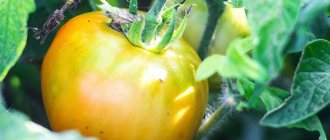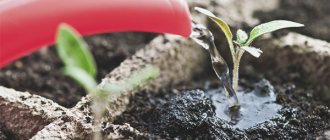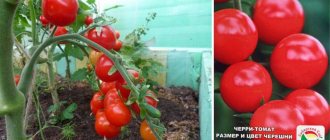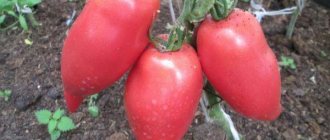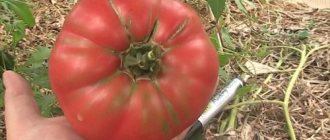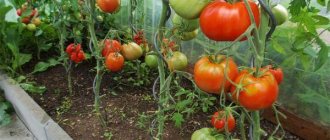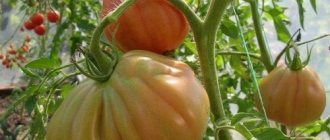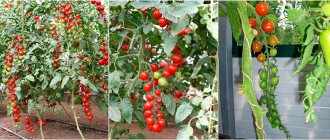Tomato Pink Clear F1 is a wonderful pink-fruited hybrid with heavy fruits that have a pleasant taste. It can be used in a number of culinary recipes and is made easy to grow due to its excellent disease resistance.
| Height | Landing location | Ripening time | Fruit color | Fruit size | Origin | Fruit shape |
| Tall | Greenhouse | Mid-season | Pink | Large | Hybrid | Flat-round |
Description and characteristics of the variety
The culture was created by Israeli breeders. The application is universal: the smallest fruits can be canned, the rest can be eaten fresh, prepared juices, sauces, added to soups, stews and slices. The hybrid is planted in all regions of the Russian Federation and neighboring countries, but in the middle zone and in the north it needs greenhouse shelters, and in the south open ground is acceptable.
The hybrid Pink Clear F1 has an indeterminate type of bush, the stems reach more than 2 meters in height. The bush is powerful, medium leafy. The leaves are dark green, medium. Tomatoes are collected in brushes containing 5-6 pieces. In terms of timing, it is mid-season - 90-105 days pass after germination before harvesting.
The fruits are pink, flat-round, the average weight of each is 100-300 g. There is light ribbing. There are few seeds inside. The pulp is sugary, not too dense, juicy, slightly sour, but generally sweet.
Tomatoes contain a lot of vitamin PP, that is, nicotinic acid, which helps eliminate toxins, and also contains B vitamins, which help the gastrointestinal tract and improve the functioning of all cells in the body.
How to grow
Pink Claire is easy to care for, but in order to get a rich harvest, experienced farmers recommend adhering to the rules of sowing, growing seedlings and planting in the ground.
Preparing and sowing seeds
Hybrid seeds do not require a disinfection procedure, but actions aimed at stimulating growth will not be superfluous. The seed material is soaked in Epin-Extra, Zircon, and Immunocytophyte products for 12 hours. Some gardeners prefer natural remedies - aloe and potato juice, infusion of onion peels and ash, honey. This will help shorten the growing season by 2-3 days and increase germination.
Sowing begins in the third ten days of February - the first ten days of March. Any container is suitable for planting seeds: plastic pots, containers, cups, juice or milk tetra packs. The depth of the container should be at least 5 cm, with holes for water to pass through.
The ideal soil for seedlings is a mixture of black soil with peat and sand in a ratio of 2:2:1. Before laying in containers, the soil is loosened and complex fertilizers are applied.
To sow, seeds are buried 2 cm into the soil, watered generously with warm water, and plastic wrap is placed on top.
As soon as the shoots appear, the film is removed and the seedlings are taken out to a windowsill with good lighting, or placed under a phytolamp. The optimal temperature is +20…+25 °C. Water moderately as the soil dries out.
Picking is carried out in large seedling boxes after the appearance of 2-3 true leaves. At the same time, complex fertilizing is applied.
Rules for planting in the ground
Planting seedlings in open soil begins in the third decade of May. A few days before this, they fertilize with mullein and chicken droppings.
The holes are filled with hot water, wait for it to cool and the seedlings are planted. Plants are placed at a distance of 60 cm from each other, since the bushes grow sprawling and require space. Tomatoes do well in soil where zucchini, beans, peas, onions, and garlic previously grew.
The row spacing is 70 cm, the type of arrangement of seedlings is checkerboard. Planting density – 3 bushes per 1 m².
The lower leaves and side shoots are removed. The bushes are tied to supports and formed into two stems.
Bush care and watering
Activities for caring for Pink Claire tomatoes include weeding, watering, fertilizing and prevention of bacterial diseases of nightshade crops.
Weeding is carried out once a week before watering. Weeds draw moisture and nutrients from the soil, so weeding is mandatory.
The bushes are watered no more than 2-3 times a week in the evening so that the leaves do not get burned. In rainy weather, watering is stopped and resumed when the heat sets in.
Moderation of watering is the main condition for obtaining tasty tomatoes. Excess moisture leads to loss of taste. The pulp becomes too watery and tasteless.
Top dressing
Fertilizers are applied regularly, with an interval of 14 days:
- For the first time, take chicken manure diluted in 10 liters of water. Ammonium nitrate, superphosphate and potassium chloride are also suitable.
- The second feeding is carried out using 1 liter of mullein infusion mixed with 25 g of superphosphate and two teaspoons of ash.
- The third fertilizer contains wood ash (3 tbsp), superphosphate (25 g) and manganese sulfate (0.5 g).
- Removal of side shoots is carried out once every 10-14 days.
Reference . If the tomatoes grow poorly and there are practically no ovaries, increase the amount of fertilizing. If the plant grows green mass, but does not form ovaries, stop fertilizing.
Growing pepper tomatoes
High yields of pepper tomatoes can be achieved if, when planting and caring for the crop, its characteristics and preferences for soil, watering and fertilizing are taken into account.
Sowing rules
Seeds of these varieties of tomatoes should be purchased from trusted producers. All pepper tomatoes are hybrids, so seeds collected from them at home will not retain the main parental characteristics. Most often, hybrid seeds are sold processed, so soaking and additional processing are not required. Pepper tomatoes are grown through seedlings. Soil for sowing can be purchased at the store or prepared independently from peat, turf soil, compost and sand in a ratio of 2:1:1:0.5. It is recommended to add 1 cup of wood ash and a complex fertilizer, which will include phosphorus, potassium and nitrogen, to a bucket of this mixture.
The soil contains all the necessary macro- and microelements for the normal development and fruiting of plants
Sowing is carried out in small containers to a depth of no more than 1 cm. The comfortable temperature for growing seedlings is +25 degrees. After the appearance of 2 true leaves, it is necessary to pick out the seedlings. This will have a beneficial effect on the development of the plant’s root system.
The young seedling is planted together with a clod of earth in order to damage the root system as little as possible.
Transplanting tomatoes into open ground
All varieties of pepper tomatoes prefer neutral or slightly acidic, well-seasoned soil. The area for growing them should be sunny and protected from the winds. Prepare it in advance:
- If the soil is highly acidic, it is necessary to lime it. During the autumn plowing of the garden, slaked lime should be added at the rate of 5 to 10 kg per 10 square meters. m per area with clay or loamy soil and up to 1.5 kg for the same area with sandy or sandy loam soil;
- in autumn and spring, manure is applied to the site at the rate of 0.5 buckets per 1 square meter. m.
Planting is carried out in holes measuring 15x15 cm and a depth of a spade bayonet. No more than 3 plants are planted per square meter. This makes it possible to easily form a bush with 2 stems, and with a denser planting you will have to leave only one stem.
If the weather is cloudy, it is recommended to plant seedlings in the morning, and if it is sunny, in the late afternoon
Growing: tips
Tomato sowing should be done in late February or early March. It is of great importance to prepare good soil, both for seedlings and in open ground. Before sowing, the seeds are disinfected in a solution of potassium permanganate for 10-15 minutes. In turn, they can be soaked in a growth stimulator for better fruiting. Soil for seedlings is bought in specialized departments for gardeners or prepared from females. To do this, mix peat, humus and a little ash. Pallets or boxes can be drained. Before placing the seeds in the ground, the holes or furrows are shed with a small amount of water. The seeds are buried at a distance of 1–1.5 cm and placed 2–3 cm apart. Afterwards they are covered with earth. For better germination, the containers are covered with film and placed in a lighted room. Picking tomatoes is carried out next to the appearance of 2 - 3 leaves
Each sprout is placed in a separate container, with the intention of not damaging the root system when planting the tomato in the ground. In order to transfer seedlings, it is important to prepare good soil and add fertilizers: potash, phosphorus, nitrogen, manure and ash. Plants are planted at a distance of 60 cm from each other.
It is necessary to change the soil with almost crops as often as possible. It is better to plant tomatoes in the soil where carrots, mess, dill and legumes grew. Do not use soil from zucchini, peppers and potatoes.

